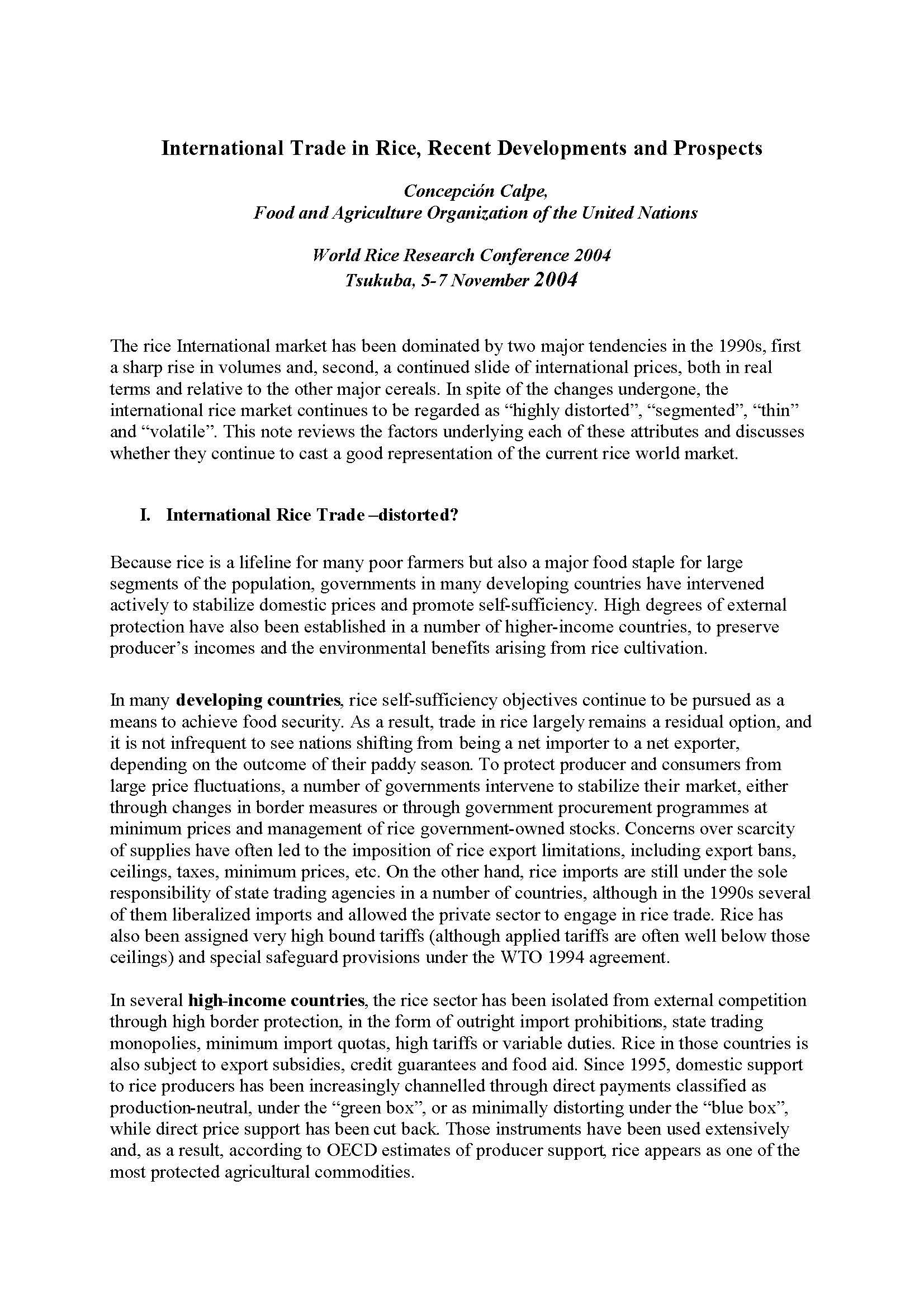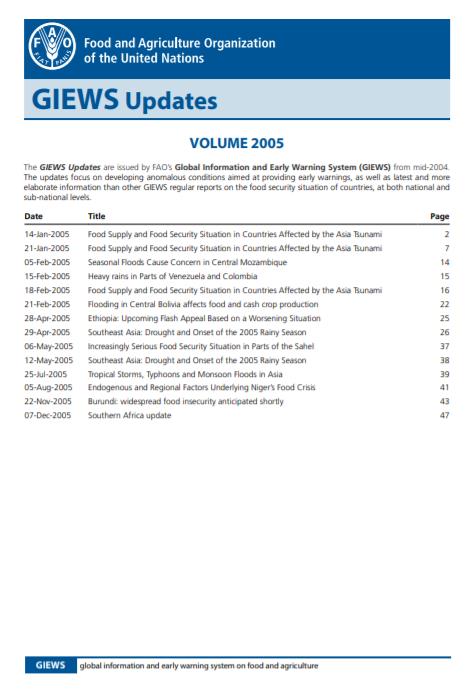
GIEWS Updates - Volume 2005
14/01/2005
The GIEWS Updates are issued by FAO’s Global Information and Early Warning System (GIEWS) from mid-2004. The updates focus on developing anomalous conditions aimed at providing early warnings, as well as latest and more elaborate information than other GIEWS regular reports on the food security situation of countries, at both national and sub-national levels.
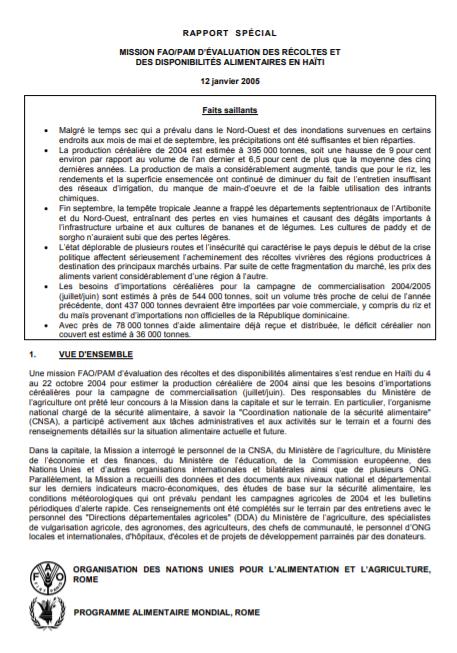
Rapport Spécial - Mission FAO/PAM D’Évaluation des Récoltes et des Disponibilités Alimentaires en Haïti
12/01/2005
Une mission FAO/PAM d’évaluation des récoltes et des disponibilités alimentaires s’est rendue en Haïti du 4 au 22 octobre 2004 pour estimer la production céréalière de 2004 ainsi que les besoins d’importations céréalières pour la campagne de commercialisation (juillet/juin). Des responsables du Ministère de l’agriculture ont prêté leur concours à la Mission dans la capitale et sur le terrain. En particulier, l’organisme national chargé de la sécurité alimentaire, à savoir la "Coordination nationale de la sécurité alimentaire" (CNSA), a participé activement aux tâches administratives et aux activités sur le terrain et a fourni des renseignements détaillés sur la situation alimentaire actuelle et future.
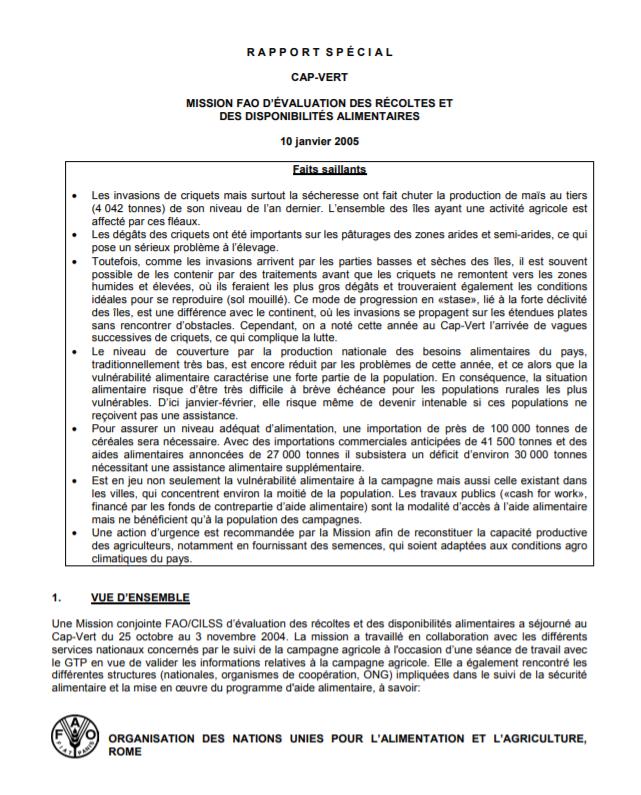
Rapport Spécial - Mission FAO D’Évaluation des Réecoltes et des Disponibilités Alimentaires en Cap-Vert
10/01/2005
Une Mission conjointe FAO/CILSS d’évaluation des récoltes et des disponibilités alimentaires a séjourné au Cap-Vert du 25 octobre au 3 novembre 2004. La mission a travaillé en collaboration avec les différents services nationaux concernés par le suivi de la campagne agricole à l'occasion d’une séance de travail avec le GTP en vue de valider les informations relatives à la campagne agricole.
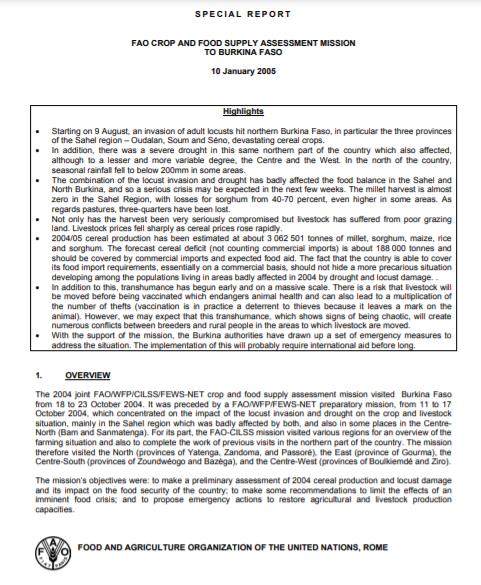
Rapport Spécial - Mission FAO D’Évaluation des Réecoltes et des Disponibilités Alimentaires en Burkina Faso
10/01/2005
La mission conjointe FAO/CILSS d’évaluation des récoltes et des disponibilités alimentaires 2004 au Burkina Faso s’est déroulée du 18 au 23 octobre 2004. Elle a été précédée d’une mission préparatoire FAO/PAM/FEWS-NET du 11 au 17 octobre 2004, qui s’est penchée sur l’impact de l’invasion acridienne et de la sécheresse sur la situation des cultures et de l’élevage, principalement dans la région du Sahel, durement affectée par ces deux chocs, ainsi que dans quelques localités dans la région du Centre-Nord (Bam et Sanmatenga). La Mission FAO/CILSS a pour sa part visité diverses régions afin d’avoir une vue d’ensemble de la situation agricole et de compléter ainsi les visites précédentes dans la partie septentrionale du pays. Elle a ainsi visité les Régions du Nord (provinces du Yatenga, du Zandoma, du Passoré), de l’Est (province du Gourma), du Centre-Sud (provinces du Zoundwéogo et du Bazèga), du Centre-Ouest (provinces du Boulkiemdé et du Ziro).
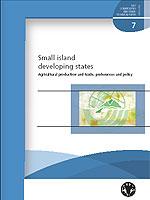
Small Island Developing States Agricultural Production and Trade, Preferences and Policy
01/01/2005
This report is meant to contribute to the continuing debate related to small states and their agriculture sectors in the multilateral trade framework. It looks at the specific challenges faced by small states and the importance of non-reciprocal preferences. It is felt that a clearer understanding of Small Island Developing States (SIDS) agricultural economies and trade and the often obscure effects of trade preferences on SIDS economic development is vital to identifying policies that will pro mote their sustainable development. This report seeks to contribute to this understanding by analysing the agricultural export performance of SIDS and evaluating the importance of their existing agricultural preferences. Four specific dimensions related to SIDS and their agricultural trade patterns, policy and performance are addressed. First, the report looks at what characterizes and differentiates SIDS and explores the possibility of categorizing SIDS as a group for special treatment in int ernational agricultural trade relations. Second, it evaluates SIDS agricultural production, trade patterns and performance. Third, it appraises the agricultural preference regimes affecting SIDS and fourth, the policy issues related to SIDS countries in the context of the WTO and EU/ACP are addressed. The report presents conclusions and options related to promoting the agricultural trade and economic development in SIDS.

The impact of import surges: country case study results for Senegal and Tanzania
01/01/2005
Measuring the impacts of import surges is a difficult task, but simple case studies illustrate some of the fundamental issues. From the two case studies examined in this paper, it was found that the impacts vary markedly in different settings and for different commodities. Thus, for example, while the negative impact on Senegal’s broiler industry came out clearly, import surges were not an issue in the case of dairy products. This was because dairy imports, although high, had increased steadily over a longer period of time and as a result the local industry had adjusted. In the case of Tanzania, some negative effects were found for the dairy sub-sector but only limited effects on poultry. In both countries, rapid growth in poultry imports also revealed the weaknesses of the domestic processing industry in competing with imported products, particularly in situations where there has been rapid growth in demand for further processed quality products by supermarkets and hotels which the lo cal industry has failed to supply.
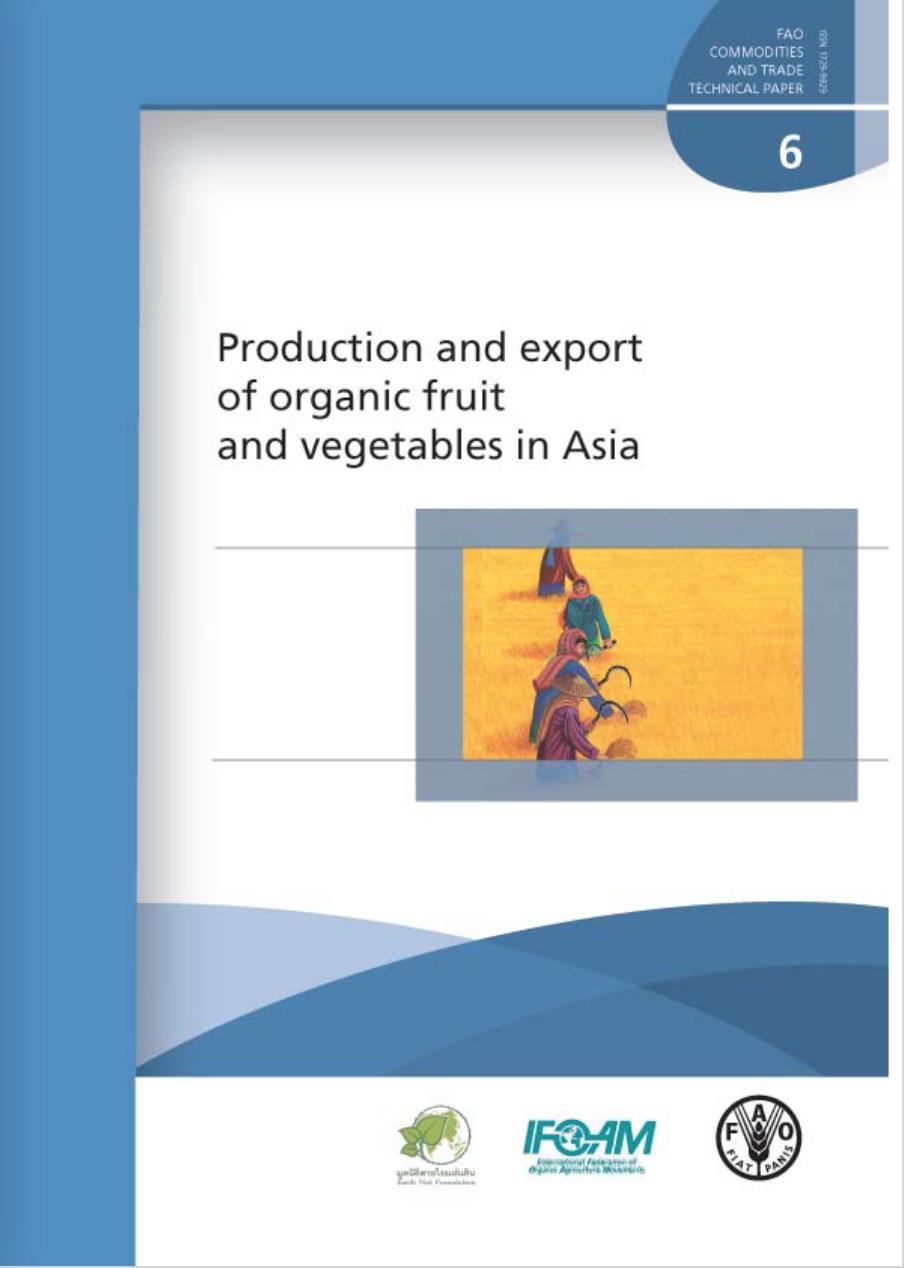
Production and Export of Organic Fruit and Vegetables in Asia
01/01/2005
This publication summarizes the presentations and discussions that took place during the International Seminar on Producing and Exporting Organic Fruit and Vegetables in Asia that was held in Bangkok, Thailand, in November 2003. It describes the market situation and outlook for organic horticultural products, the opportunities offered by the main import markets (North America, the European Union and Japan) and their import requirements. The publication examines the ways in which Asian countries could take advantage of potential market opportunities. Case studies on the development of the organic agriculture sector in Thailand, China and India are presented. The publication analyzes the constraints to overcome in order to successfully produce and export organic horticultural products, and discusses strategy options for the development of production and exports in Asia.
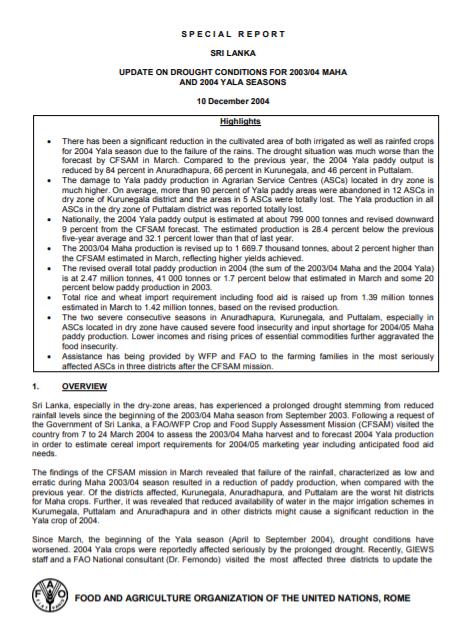
Special Report - Update on Drought Conditions for 2003/04 Maha and 2004 Yala Seasons - Sri Lanka
10/12/2004
Sri Lanka, especially in the dry-zone areas, has experienced a prolonged drought stemming from reduced rainfall levels since the beginning of the 2003/04 Maha season from September 2003.
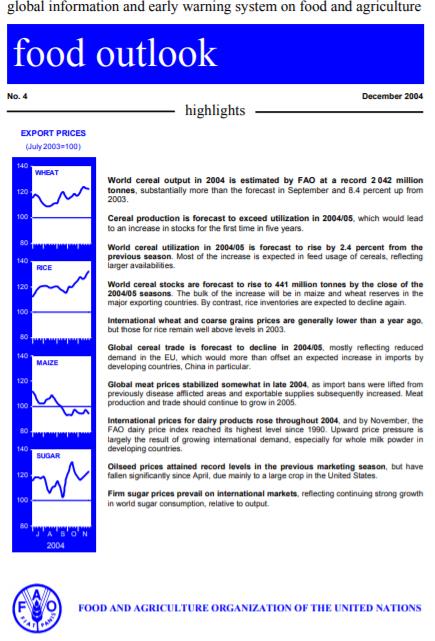
Food Outlook - December 2004
03/12/2004
World cereal output in 2004 is estimated by FAO at a record 2 042 million tonnes, substantially more than the forecast in September and 8.4 percent up from 2003. Cereal production is forecast to exceed utilization in 2004/05, which would lead to an increase in stocks for the first time in five years. World cereal utilization in 2004/05 is forecast to rise by 2.4 percent from the previous season. Most of the increase is expected in feed usage of cereals, reflecting larger availabilities. World cereal stocks are forecast to rise to 441 million tonnes by the close of the 2004/05 seasons. The bulk of the increase will be in maize and wheat reserves in the major exporting countries. By contrast, rice inventories are expected to decline again. International wheat and coarse grains prices are generally lower than a year ago, but those for rice remain well above levels in 2003. Global cereal trade is forecast to decline in 2004/05, mostly reflecting reduced demand in the EU, which would more than offset an expected increase in imports by developing countries, China in particular. Global meat prices stabilized somewhat in late 2004, as import bans were lifted from previously disease afflicted areas and exportable supplies subsequently increased. Meat production and trade should continue to grow in 2005. International prices for dairy products rose throughout 2004, and by November, the FAO dairy price index reached its highest level since 1990. Upward price pressure is largely the result of growing international demand, especially for whole milk powder in developing countries. Oilseed prices attained record levels in the previous marketing season, but have fallen significantly since April, due mainly to a large crop in the United States. Firm sugar prices prevail on international markets, reflecting continuing strong growth in world sugar consumption, relative to output.
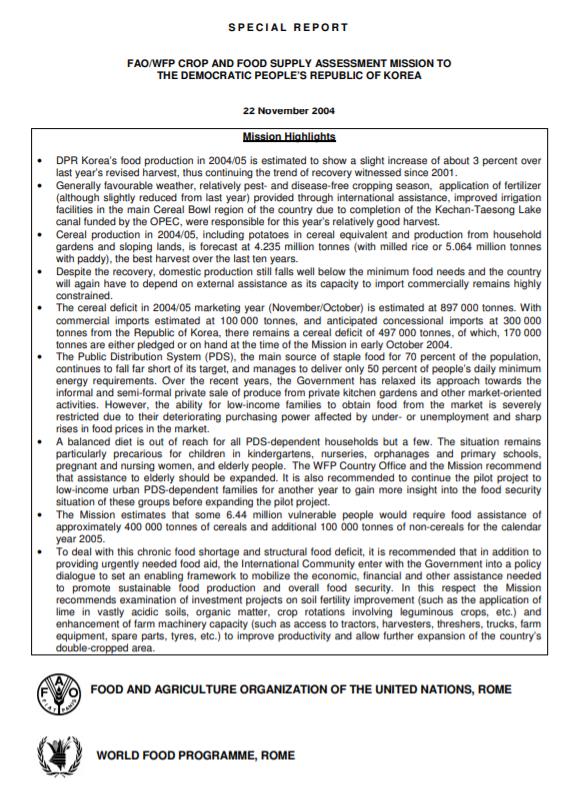
Special Report - FAO/WFP Crop and Food Supply Assessment Mission to the Democratic People's Republic of Korea - 22 November 2004
22/11/2004
An FAO/WFP Crop and Food Supply Assessment Mission visited DPR Korea from 28 September to 9 October to assess the 2004 main-crop harvest, forecast 2005 production of winter and spring crops (wheat, barley and potatoes) and estimate cereal import requirements for the 2004/05 marketing year (November/October), including food-aid needs.
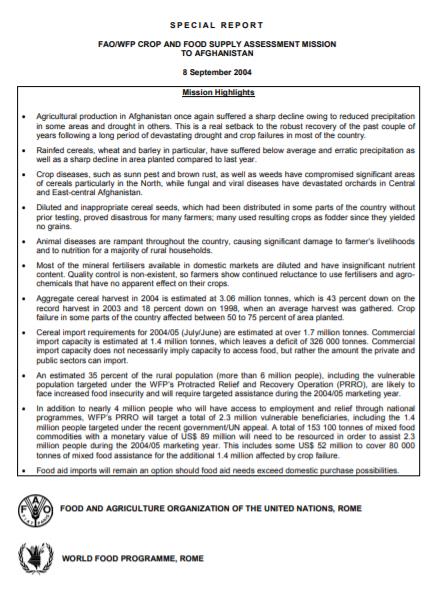
Special Report - FAO/WFP Crop and Food Supply Assessment Mission to Afghanistan - 8 September 2004
08/09/2004
A joint FAO/WFP Crop and Food Supply Assessment Mission (CFSAM), visited Afghanistan between 8 July and 7 August 2004, to estimate the 2004 cereal harvest and forecast cereal import requirements for the 2004/05 (July/June) marketing year. The mission was requested by the Government of Afghanistan following reports of widespread crop failures due to drought in most of the country except the Northern provinces. The CFSAM was preceded by an inter-ministerial drought assessment task force mission covering some of the affected provinces in the South and West of the country. The CFSAM worked in closer collaboration with FEWSNET and the Ministry of Agriculture and Animal Husbandry (MAAH).
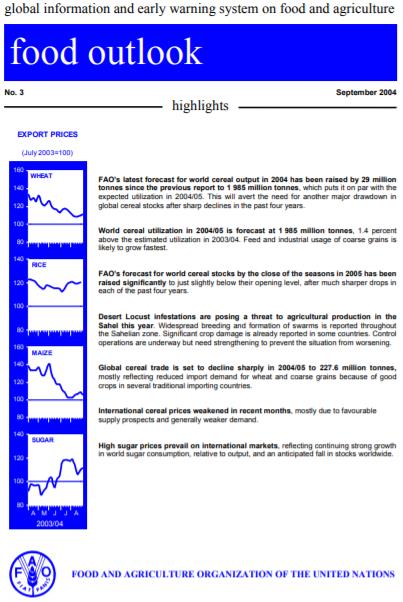
Food Outlook - September 2004
03/09/2004
FAO’s latest forecast for world cereal output in 2004 has been raised by 29 million tonnes since the previous report to 1 985 million tonnes, which puts it on par with the expected utilization in 2004/05. This will avert the need for another major drawdown in global cereal stocks after sharp declines in the past four years. World cereal utilization in 2004/05 is forecast at 1 985 million tonnes, 1.4 percent above the estimated utilization in 2003/04. Feed and industrial usage of coarse grains is likely to grow fastest. FAO’s forecast for world cereal stocks by the close of the seasons in 2005 has been raised significantly to just slightly below their opening level, after much sharper drops in each of the past four years. Desert Locust infestations are posing a threat to agricultural production in the Sahel this year. Widespread breeding and formation of swarms is reported throughout the Sahelian zone. Significant crop damage is already reported in some countries. Control operations are underway but need strengthening to prevent the situation from worsening. Global cereal trade is set to decline sharply in 2004/05 to 227.6 million tonnes, mostly reflecting reduced import demand for wheat and coarse grains because of good crops in several traditional importing countries. International cereal prices weakened in recent months, mostly due to favourable supply prospects and generally weaker demand. High sugar prices prevail on international markets, reflecting continuing strong growth in world sugar consumption, relative to output, and an anticipated fall in stocks worldwide.
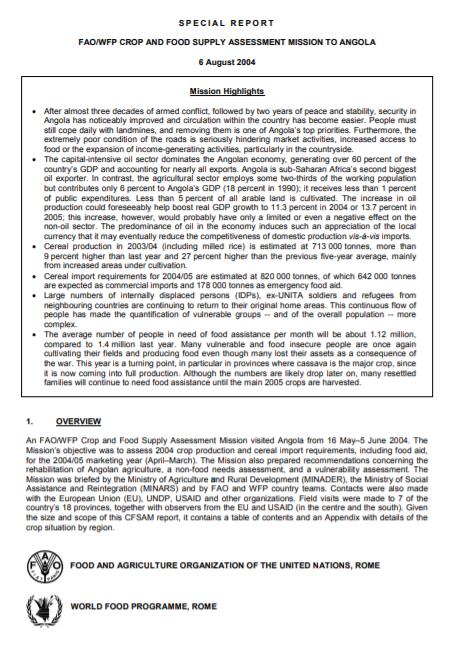
Special Report - FAO/WFP Crop and Food Supply Assessment Mission to Angola - 6 August 2004
06/08/2004
An FAO/WFP Crop and Food Supply Assessment Mission visited Angola from 16 May–5 June 2004. The Mission’s objective was to assess 2004 crop production and cereal import requirements, including food aid, for the 2004/05 marketing year (April–March). The Mission also prepared recommendations concerning the rehabilitation of Angolan agriculture, a non-food needs assessment, and a vulnerability assessment. The Mission was briefed by the Ministry of Agriculture and Rural Development (MINADER), the Ministry of Social Assistance and Reintegration (MINARS) and by FAO and WFP country teams. Contacts were also made with the European Union (EU), UNDP, USAID and other organizations. Field visits were made to 7 of the country’s 18 provinces, together with observers from the EU and USAID (in the centre and the south). Given the size and scope of this CFSAM report, it contains a table of contents and an Appendix with details of the crop situation by region.
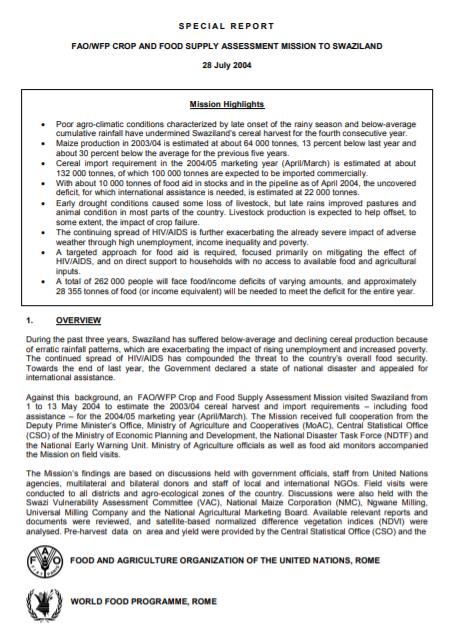
Special Report - FAO/WFP Crop and Food Supply Assessment Mission to Swaziland - 28 July 2004
28/07/2004
An FAO/WFP Crop and Food Supply Assessment Mission visited Swaziland from 1 to 13 May 2004 to estimate the 2003/04 cereal harvest and import requirements – including food assistance – for the 2004/05 marketing year (April/March). The Mission received full cooperation from the Deputy Prime Minister’s Office, Ministry of Agriculture and Cooperatives (MoAC), Central Statistical Office (CSO) of the Ministry of Economic Planning and Development, the National Disaster Task Force (NDTF) and the National Early Warning Unit. Ministry of Agriculture officials as well as food aid monitors accompanied the Mission on field visits.
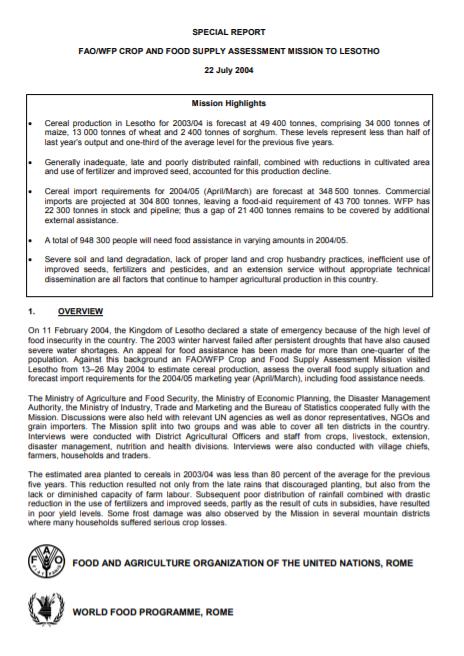
Special Report - FAO/WFP Crop and Food Supply Assessment Mission to Lesotho - 22 July 2004
22/07/2004
On 11 February 2004, the Kingdom of Lesotho declared a state of emergency because of the high level of food insecurity in the country. The 2003 winter harvest failed after persistent droughts that have also caused severe water shortages. An appeal for food assistance has been made for more than one-quarter of the population. Against this background an FAO/WFP Crop and Food Supply Assessment Mission visited Lesotho from 13–26 May 2004 to estimate cereal production, assess the overall food supply situation and forecast import requirements for the 2004/05 marketing year (April/March), including food assistance needs.
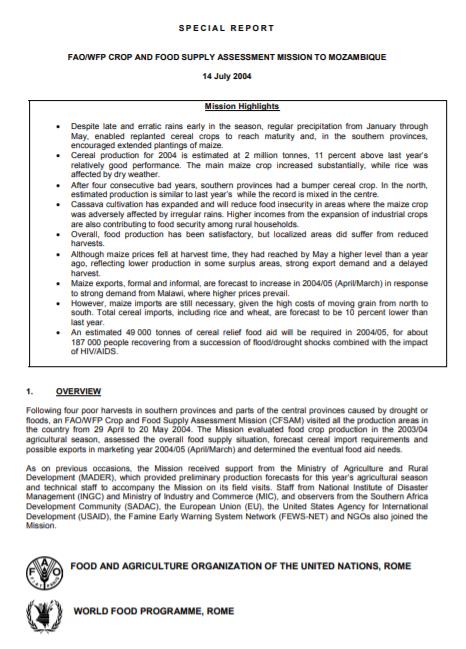
Special Report - FAO/WFP Crop and Food Supply Assessment Mission to Mozambique - 14 July 2004
14/07/2004
Following four poor harvests in southern provinces and parts of the central provinces caused by drought or floods, an FAO/WFP Crop and Food Supply Assessment Mission (CFSAM) visited all the production areas in the country from 29 April to 20 May 2004. The Mission evaluated food crop production in the 2003/04 agricultural season, assessed the overall food supply situation, forecast cereal import requirements and possible exports in marketing year 2004/05 (April/March) and determined the eventual food aid needs.
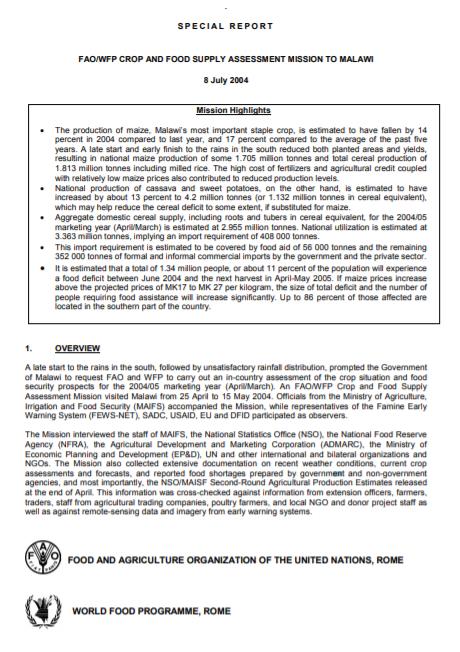
Special Report - FAO/WFP Crop and Food Supply Assessment Mission to Malawi - 8 July 2004
08/07/2004
A late start to the rains in the south, followed by unsatisfactory rainfall distribution, prompted the Government of Malawi to request FAO and WFP to carry out an in-country assessment of the crop situation and food security prospects for the 2004/05 marketing year (April/March). An FAO/WFP Crop and Food Supply Assessment Mission visited Malawi from 25 April to 15 May 2004. Officials from the Ministry of Agriculture, Irrigation and Food Security (MAIFS) accompanied the Mission, while representatives of the Famine Early Warning System (FEWS-NET), SADC, USAID, EU and DFID participated as observers.
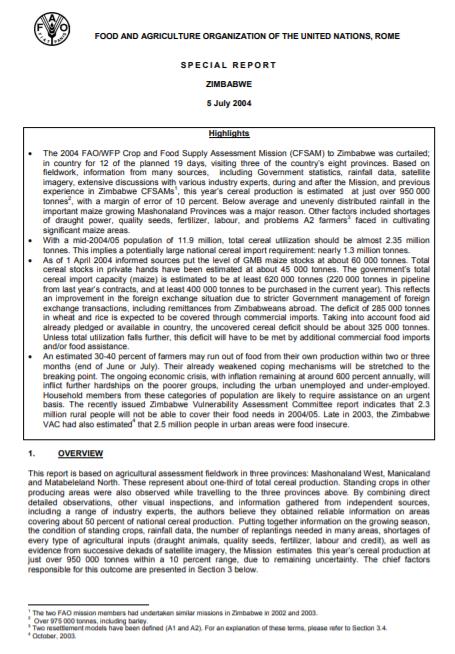
Special Report - FAO/WFP Crop and Food Supply Assessment Mission to Zimbabwe - 5 July 2004
05/07/2004
The 2004 FAO/WFP Crop and Food Supply Assessment Mission (CFSAM) to Zimbabwe was curtailed; in country for 12 of the planned 19 days, visiting three of the country’s eight provinces. Based on fieldwork, information from many sources, including Government statistics, rainfall data, satellite imagery, extensive discussions with various industry experts, during and after the Mission, and previous experience in Zimbabwe CFSAMs, this year’s cereal production is estimated at just over 950 000 tonnes, with a margin of error of 10 percent. Below average and unevenly distributed rainfall in the important maize growing Mashonaland Provinces was a major reason. Other factors included shortages of draught power, quality seeds, fertilizer, labour, and problems A2 farmers faced in cultivating significant maize areas.
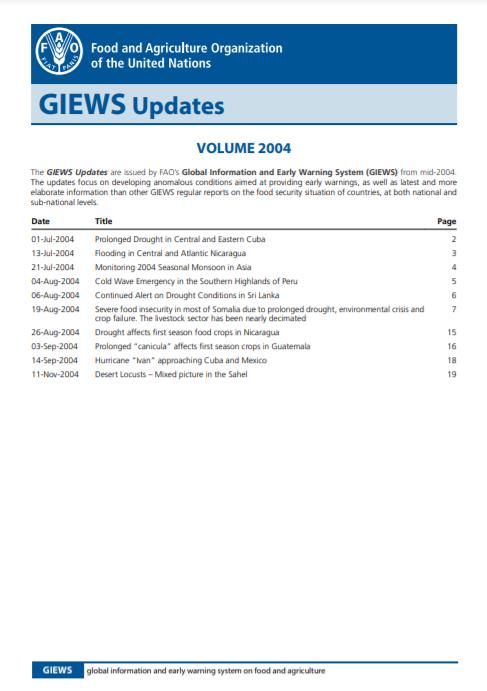
GIEWS Updates - Volume 2004
01/07/2004
The GIEWS Updates are issued by FAO’s Global Information and Early Warning System (GIEWS) from mid-2004. The updates focus on developing anomalous conditions aimed at providing early warnings, as well as latest and more elaborate information than other GIEWS regular reports on the food security situation of countries, at both national and sub-national levels.

